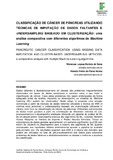| dc.relation | AHMED, M.; SERAJ, R.; ISLAM, S. M. S. The k-means Algorithm: A Comprehensive
Survey and Performance Evaluation. Electronics, v. 9, n. 8, ago. 2020.
BAI, L.; LIANG, J.; GUO, Y. An Ensemble Clusterer of Multiple Fuzzy k-Means Clus terings to Recognize Arbitrarily Shaped Clusters. IEEE Transactions on Fuzzy Sys tems, v. 26, n. 6, p. 3524-3533, dez. 2018.
CHARBUTY, B.; ABDULAZEEZ, A. Classification Based on Decision Tree Algorithm
for Machine Learning. Journal of Applied Science and Technology Trends, v. 2,
n. 01, p. 20-28, mar. 2021.
CHEN, PH. C.; LIU, Y.; PENG, L. How to develop machine learning models for
healthcare. Nature Materials, v. 18, p. 410–414, abr. 2019.
CHEN, T.; GUESTRIN, C. XGBoost: A Scalable Tree Boosting System. Proceed ings of the 22nd ACM SIGKDD International Conference on Knowledge Discov ery and Data Mining, Association for Computing Machinery, p. 785–794, ago. 2016.
CHICCO, D.; JURMAN, G. The advantages of the Matthews correlation coefficient
(MCC) over F1 score and accuracy in binary classification evaluation. BMC Ge nomics, v. 21, n. 6, jan. 2020.
DHEEBA, J.; ALBERT SINGH, N.; TAMIL SELVI, S. Computer-aided detection of
breast cancer on mammograms: A swarm intelligence optimized wavelet neural net work approach. Journal of Biomedical Informatics, v. 49, p. 45–52, jun. 2014.
ESTEVA, A. et al. Dermatologist-level classification of skin cancer with deep neural
networks. Nature, v. 542, p. 115-118, jan. 2017.
GHORI, K. M. et al. Performance Analysis of Different Types of Machine Learning
Classifiers for Non-Technical Loss Detection. IEEE Access, v. 8, p. 16033-16048,
jan. 2020.
GUZMÁN-PONCE, A. et al. A New Under-Sampling Method to Face Class Overlap
and Imbalance. Applied Sciences, v. 10, n. 15, p. 5164, jul. 2020.
HASANIN, T. et al. Investigating Random Undersampling and Feature Selection on
Bioinformatics Big Data. 2019 IEEE Fifth International Conference on Big Data
Computing Service and Applications (BigDataService), p. 346-356, abr. 2019.
HASSAN, N. S. et al. Medical Images Breast Cancer Segmentation Based on K Means Clustering Algorithm: A Review. Asian Journal of Research in Computer
Science, v. 9, n. 1, p. 23–38, mai. 2021.
JIANG, F. et al. Artificial intelligence in healthcare: Past, present and future. Stroke
and Vascular Neurology, v. 2, n. 4, p. 230–243, jun. 2017.
JUNG, Y. Multiple predicting K-fold cross-validation for model selection. Journal of
Nonparametric Statistics, v. 30, p. 197-215, nov. 2017.
KAISER, J. Dealing with Missing Values in Data. Journal of Systems Integration, v.
5, p. 42-51, nov. 2014.
KARRAR, A. E. The Effect of Using Data Pre-Processing by Imputations in Handling
Missing Values. Indonesian Journal of Electrical Engineering and Informatics, v.
10, n. 2, jun. 2022.
KSIAZEK, W. et al. Development of novel ensemble model using stacking learning
and evolutionary computation techniques for automated hepatocellular carcinoma
detection. Biocybernetics and Biomedical Engineering, v. 40, n. 4, p. 1512-1524,
out. 2020.
KURANI, A. et al. A Comprehensive Comparative Study of Artificial Neural Network
(ANN) and Support Vector Machines (SVM) on Stock Forecasting. Annals of Data
Science, v. 10, p. 183–208, fev. 2023.
PANDEY, A.; JAIN, A. Comparative Analysis of KNN Algorithm using Various Nor malization Techniques. International Journal of Computer Network and Infor mation Security, v. 9, p. 36-42, nov. 2017.
PROROK, P. C. et al. Design of the prostate, lung, colorectal and ovarian (PLCO)
cancer screening trial. Control Clin. Trials, v. 21, p. 273S-309S, dez. 2000.
QIN, J. et al. Distributed k-Means Algorithm and Fuzzy c-Means Algorithm for Sensor
Networks Based on Multiagent Consensus Theory. IEEE Transactions on Cyber netics, v. 47, n. 3, p. 772-783, mar. 2017.
SCHONLAU, M.; ZOU, R. Y. The random forest algorithm for statistical learning. The
Stata Journal, v. 20, n. 1, p. 3-29, mar. 2020.
SUBASI, A. Machine learning techniques. In: ____. Practical Machine Learning for
Data Analysis Using Python, Academic Press, 2020. cap. 3.
SUNG, H. et al. Global Cancer Statistics 2020: GLOBOCAN Estimates of Incidence
and Mortality Worldwide for 36 Cancers in 185 Countries. CA Cancer J. Clin., v. 71,
n. 3, p. 209-249, fev. 2021.
TAN, J.; MOORE, J.; URBANOWICZ, R. Rapid Rule Compaction Strategies for
Global Knowledge Discovery in a Supervised Learning Classifier System. ECAL
2013: The Twelfth European Conference on Artificial Life, p. 110-117, set. 2013.
URBANOWICZ, R. et al. A rigorous machine learning analysis pipeline for biomedical
binary classification: application in pancreatic cancer nested case-control studies with
implications for bias assessments. ArXiv, v. abs/2008.12829v2, set. 2020.
URBANOWICZ, R. ExSTraCS ML Pipeline Binary Notebook, set. 2020. Disponível
em: <https://github.com/UrbsLab/ExSTraCS_ML_Pipeline_Binary_Notebook>. Aces so em: 1 out. 2022.
URBANOWICZ, R. J.; MOORE, J. H. ExSTraCS 2.0: Description and Evaluation of a
Scalable Learning Classifier System. Evolutionary Intelligence, v. 8, n. 2, p. 89-
116, set. 2015.
VUTTIPITTAYAMONGKOL, P.; ELYAN, E.; PETROVSKI, A. On the class overlap
problem in imbalanced data classification. Knowledge-Based Systems, v. 212, jan.
2021.
WEI, L. et al. Gene Expression Value Prediction Based on XGBoost Algorithm. Fron tiers in Genetics, v. 10, nov. 2019.
WEI, X. A Method of Enterprise Financial Risk Analysis and Early Warning Based on
Decision Tree Model. Security and Communication Networks, v. 2021, set. 2021.
WEI-CHAO, L. et al. Clustering-based undersampling in class-imbalanced data. In formation Sciences, v. 409-410, p. 17-26, out. 2017.
WICKRAMASINGHE, I.; KALUTARAGE, H. Naive Bayes: applications, variations and
vulnerabilities: a review of literature with code snippets for implementation. Soft
Computing, v. 25, p. 2277–2293, set. 2020.
WINTER, K. et al. Diagnostic and therapeutic recommendations in pancreatic ductal
adenocarcinoma. Recommendations of the Working Group of the Polish Pancreatic
Club. Przeglad gastroenterologiczny, v. 14, n. 1, p. 1-18, mar. 2019.
WU, X. et al. Imputation techniques on missing values in breast cancer treatment and
fertility data. Health Information Science and Systems, v. 7, p. 19, out. 2019.
YANG, D. X. et al. Prevalence of Missing Data in the National Cancer Database and
Association with Overall Survival. JAMA Network Open, v. 4, n. 3, p. e211793, mar.
2021.
ZHANG, J.; CHEN, L.; ABID, F. Prediction of Breast Cancer from Imbalance Respect
Using Cluster-Based Undersampling Method. Journal of Healthcare Engineering,
v. 2019, out. 2019. | pt_BR |


